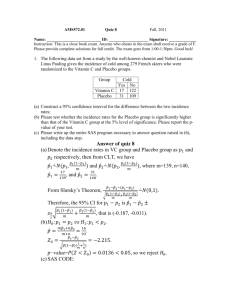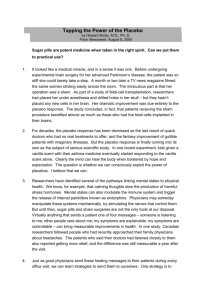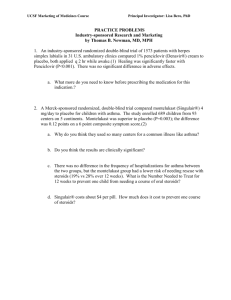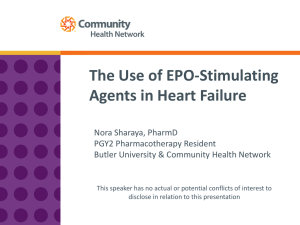Worksheet 2 - Purdue University
advertisement
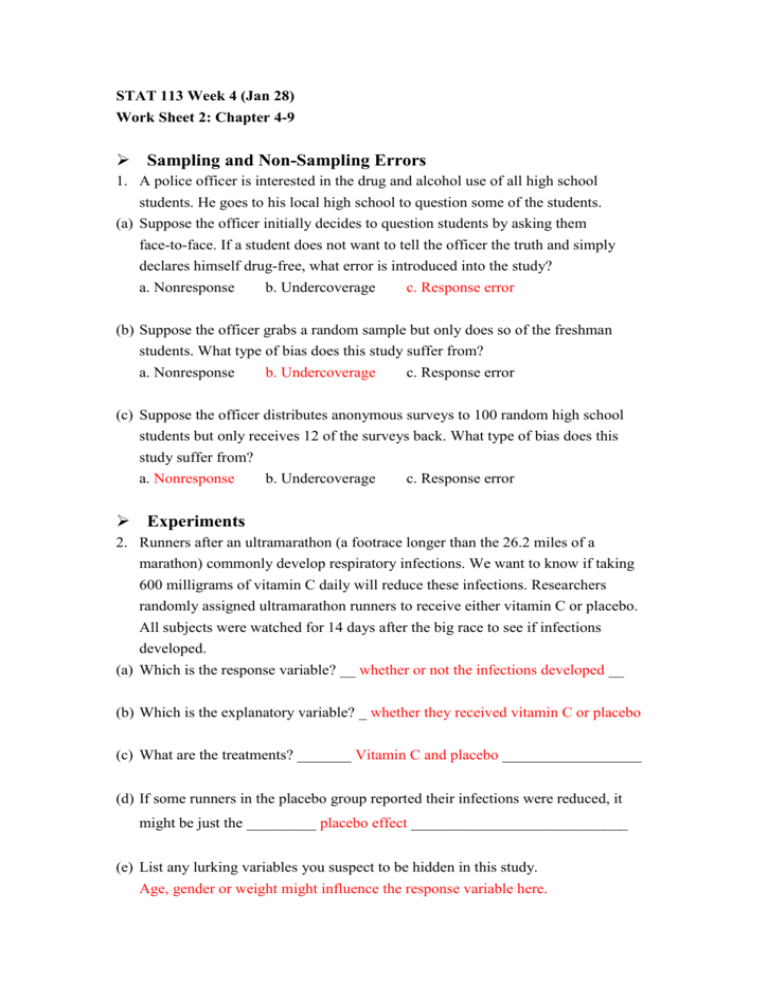
STAT 113 Week 4 (Jan 28) Work Sheet 2: Chapter 4-9 Sampling and Non-Sampling Errors 1. A police officer is interested in the drug and alcohol use of all high school students. He goes to his local high school to question some of the students. (a) Suppose the officer initially decides to question students by asking them face-to-face. If a student does not want to tell the officer the truth and simply declares himself drug-free, what error is introduced into the study? a. Nonresponse b. Undercoverage c. Response error (b) Suppose the officer grabs a random sample but only does so of the freshman students. What type of bias does this study suffer from? a. Nonresponse b. Undercoverage c. Response error (c) Suppose the officer distributes anonymous surveys to 100 random high school students but only receives 12 of the surveys back. What type of bias does this study suffer from? a. Nonresponse b. Undercoverage c. Response error Experiments 2. Runners after an ultramarathon (a footrace longer than the 26.2 miles of a marathon) commonly develop respiratory infections. We want to know if taking 600 milligrams of vitamin C daily will reduce these infections. Researchers randomly assigned ultramarathon runners to receive either vitamin C or placebo. All subjects were watched for 14 days after the big race to see if infections developed. (a) Which is the response variable? __ whether or not the infections developed __ (b) Which is the explanatory variable? _ whether they received vitamin C or placebo (c) What are the treatments? _______ Vitamin C and placebo __________________ (d) If some runners in the placebo group reported their infections were reduced, it might be just the _________ placebo effect ____________________________ (e) List any lurking variables you suspect to be hidden in this study. Age, gender or weight might influence the response variable here. (f) The type of design used here is a. Matched pairs design c. Randomized block design b. Completely randomized design d. Stratified random sample (g) Were the 3 principles of good experimental design used here? Discuss each one with a sentence, if you don’t have enough evidence to say that one of the principles was used, say that. 1) Control: the placebo group 2) Randomization: ultramarathon runners were randomly assigned to receive either vitamin C or placebo 3) Replication: did not talk about how many subjects were used here (h) If we separate the runners into two age groups (younger than 25 years old or older) and randomly assign treatments within each group, the type of design used here is a. Matched pairs design b. Completely randomized design c. Randomized block design d. Stratified random sample (i) Group the runners into pairs based on their age and gender, and then randomly assign treatments within each pair, the type of design used here is a. Matched pairs design c. Randomized block design b. Completely randomized design d. Stratified random sample (j) During the study, if neither the subjects nor the people who worked with them knew which treatment each subject is receiving, this is an example of a a. Matched pairs design b. Block design c. Double-blind experiment Data Ethics 3. The 3Rs of ethical experiments with animals are important from legal, ethical and scientific standpoint. Identify which principle was applied in each of the following experiments: (a) Researchers moved their rats from a very dirty cage to another one with a cleaner and solid floor so the rats can remain less stressed. a. Replacement b. Reduction c. Refinement (b) Animals have been used extensively for teaching and demonstration of biological principles. Instead of using real animals, researchers used computer-based programs to show students the effects of manipulating various organ systems. a. Replacement b. Reduction c. Refinement (c) Researchers used one control group with several treatment groups rather than one control group for each treatment group in order to minimize the number of control animals. a. Replacement b. Reduction c. Refinement 4. Some researchers from a university wanted to study whether a new vaccine can protect against HIV. They planned to test the vaccine using a treatment group and a placebo group. Written informed consent was obtained for all participants or proxies, and the information about individual subjects was never made public. Were the 3 principles of ethical experiments used here? Discuss each one, if you don’t have enough evidence to say that one of the principles was used, say that. 1) Review board: was not mentioned in the above paragraph 2) Informed consent: written informed consent was obtained for all participants or proxies 3) Confidentiality: information about individual subjects was never made public Measurements 5. A Visual Example of Bias and Reliability: Identify for each board whether or not it is biased and whether or not it is reliable: (a) (b) (c) (d) (a) Reliable but biased (c) Biased and not reliable (b) Unbiased but not reliable (d) Unbiased and reliable 6. If we measure a student’s readiness for college by recording his weight in pounds, this measurement is a. Biased b. Valid c. Invalid d. Blind e. Replicated Arithmetic with Percentages 7. In January of 1997, the price of Intel common stock rose from $131 per share to $162 per share. What percent increase is this? 162 − 131 × 100 = 23.66% 131 8. The Dow Jones Industrial Average (DJIA) is the most common measure of stock market prices. Suppose that the DJIA starts at 11,421 points and drops 500 points. What percent decrease is this? −500 × 100 = −4.38% 11421

